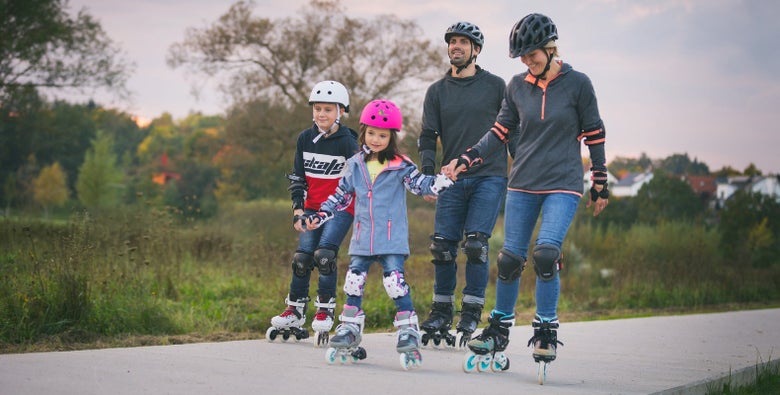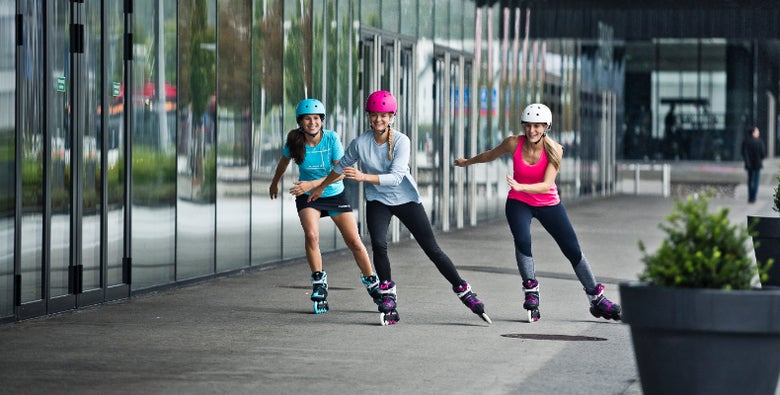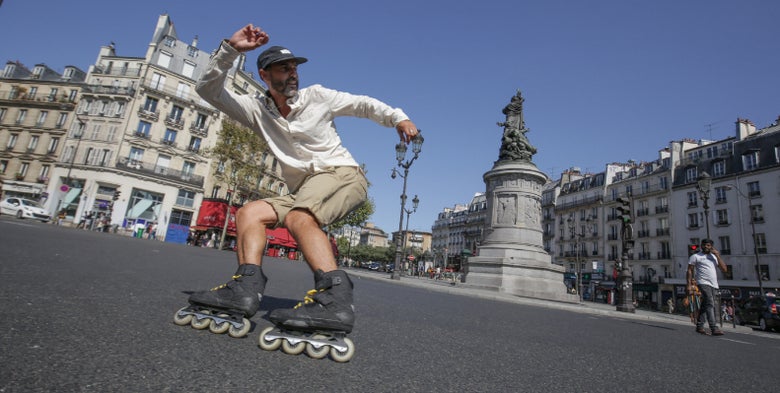Inline Skate Buying Guide
With a wide range of inline skates built for varying types of skating, it can be difficult to find the skate that is best suited for you. This guide will take you through the many options presented on our site to help you use our filters and product descriptions to narrow down the field. Sizing is not one of the characteristics covered. We do recommend exploring our Skate Sizing Guide prior to purchasing skates. The main factors we will guide you through on this page are:
- Brand
- Gender
- Skate Type
- Skill Level
- Wheel Size
- Skate Features
Brand
Certain brands specialize in specific skate types while others offer a wide range of options. Brand preference comes from personal preference or recommendation. If you do not have a brand preference, we suggest browsing based on skate type to give you the most well-rounded options. If working on someone else’s recommendation, remember that what works for one person may not work for another.
IW stands behind all of the skate brands that we stock. Most big box stores and marketplace vendors carry low-end brands that are uncomfortable, flimsy and break very quickly. When shopping with Inline Warehouse, you are guaranteed to get a high-quality skate that you can enjoy without limitations.
Gender
Skates are broken up by gender in our navigation as well as in the skate filter with the options of Mens, Womens, Unisex, Boys and Girls. Manufacturers will change the fit, color and sizing based on which gender a skate is designed for.

Mens
Mens models are designed for a man’s foot and follow US Men’s sizing. Unisex models are included in this filter and are displayed in the Men's Skates Categories.
Womens
Women’s models are designed specifically for women. The cuffs are typically slightly lower than those found in Men's models and the forefoot is sometimes slightly wider for a better fit to the female anatomy. Unisex models are NOT included in this filter but they will be displayed on the Women's skate pages.
Unisex
Unisex skates are very common, especially in more specialized skate types like speed or slalom. These skates are based on men’s sizing but are designed to be used by both men & women. If you feel that the women's options are lacking, we suggest considering unisex models to find the perfect skate to suit your needs.
Boys & Girls
Sizing and fit is the same between boy's and girl's skates but they will vary in color. Kids specific skates often feature adjustable sizing and are adaptable up to a kid's size 8! Typically blue, green and red skates are considered "boy's" and purple, pink and white skates are considered "girl's." For the largest selection, we recommend browsing both boy's and girl's options for your young skater.
Skate Types
Some skates specialize to be a certain type, while others are more versatile for use across different styles. Inline Warehouse has two pages dedicated to the different disciplines of skating. On the IW Fitness page, you will see Recreational, Cross-Training and Speed skates predominantly featured; whereas on the IW Street page, you will be immersed in the adrenaline-filled world of Aggressive, Urban and All-Terrain skating.
IW Fitness Skate Types
Recreational Skates
These skates target beginning and casual skaters. Focused on comfort and stability with a relaxed fit that requires little to no break-in time. These skates forego high-end performance features to keep the cost down. Recreational skates are best suited for short, less demanding skate sessions.
It is recommended that true beginners limit their search to skates with small wheels (78-80mm). This will keep the speed down and control high.
3-wheel models in this category have wheels as large as 100mm. Having short maneuverable frames, these larger wheeled skates are remarkably easy to skate (similar to a 4x84mm) and benefit from maintaining their roll longer and getting over cracks and bumps more easily. Top speed is much faster, so practice on a flat surface first.
Cross-Training Skates
Also known as X-Fit Skates, these target those having some experience on wheels who are skating as part of a workout routine. As skill and/or workout regiments vary, so do the performance features found on these models. A more contoured fit improves performance, though many of these skates are still comfortable right out of the box. Break-in time is to be expected on higher-end models but is accomplished quickly through one or two skate sessions with the natural heat of your feet. Skating ability and location are the key factors in choosing from the many different wheel sizes and models within this category.
Overall top speed increases with wheel size, as does the ability to maintain roll and get over cracks and bumps. A tall skate, however, will have less maneuverability when compared to one lower to the ground so be mindful of how busy your surroundings will be.
Speed Skates
Specialized for distance or marathon enthusiasts skating at a competitive level, the ultra stiff construction of Speed Skates provides optimal power transfer once properly fitted to your foot. They most often require heat molding and will not be comfortable out of the box.
The low-cut design of speed boots allows for a full range of motion to gain a better edge on the large wheels and allow for a longer, stronger stride. A skater would need to progress toward this type of boot, rather than start out with one. Entry-level speed skates have slightly higher cuffs for added support but are not to be confused with skates designed for true skating beginners. Every speed skate requires ankle strength that is earned with hard work and experience.
Prices fluctuate with the engineering and design ingenuity used to create optimal performance. Complete assemblies continue to differentiate through frame and wheel quality.
3-Wheel and 4-Wheel models are available, all with large wheel sizes. Larger wheels will require more strength in stride to get up to speed, so 4x100 and 4x110 setups are popular while 3x125 setups are the fastest and are preferred by many long course racers. Frames/wheels are easily changed, so start with what is appropriate for you now, knowing you can move up to larger wheels later on.
IW Street Skate Types
Aggressive Skates
Aggressive Skates are specialized for jumping, sliding and grinding in the skate park (or anywhere else with a good ledge or drop). Wheels under 60mm are most common create a low center of gravity to help perform and land tricks. Small wheels do limit speed substantially so some skaters prefer Aggressive skates with slightly larger wheels (up to 80mm) commonly referred to as Powerblades.
Boots are most commonly constructed using a hard molded plastic shell with a few top-end models using carbon. Skilled aggressive skaters performing difficult tricks and jumps would benefit most from the more expensive, stiffer and lighter weight carbon boots. All Aggressive boots use UFS mounting to allow for easy customization and replacement of grind parts.
Urban Skates
These models are hybrids of aggressive, cross-training and freestyle skates. This makes them versatile but also means that models can vary greatly depending on which discipline it favors most. Because they are hybrids, many Urban Skates are listed in more than one category on our site and in our Skate Filter.
As implied by the name, Urban Skates are intended for use in urban areas. Whether used to commute, exercise or just have fun the hard shell boot design most commonly found on urban skates provides the durability and response needed in rough, crowded street settings.
3 and 4-wheel models at 90-125mm wheel size can achieve great speed and cover ground quickly, much like a Cross-Trainer. 4-wheel models using smaller 80-84mm wheels focus more on quickness and control, much like an aggressive or freestyle skate. Strong, durable components help with frequent changes in direction or even jumping and sliding.
Not all urban skates come with a brake as it limits agility; check the product descriptions for additional brake information prior to purchasing.
Freestyle Skates
Also known as Slalom Skates, these are specialized for precision skating such as dancing or weaving around cones. They are designed to be low-volume, tight-fitting skates that respond acutely to a skater’s demands. Quality and price are on the high end of the spectrum due to the extreme demands put on these skates. Advanced freestylers will benefit most from the most advanced carbon models that are stiffest and lightest. 4-wheel configurations between 76-80mm keep center of gravity low and maneuverability high.
Integrated liners (not removable) are common, requiring considerable break-in time that results in a glove-like custom fit. A common error is thinking a skate too small out of the box, only to exchange for a larger size. Freestyle skates on average will break in ½ to 1 full size larger after 60+ minutes of skating.
All-Terrain Skates
All-Terrain Skates can be used on the pavement, and off-road. Large air tires easily get over twigs, dirt and other small obstacles. They are much slower than urethane wheels and are often skated downhill or with poles as off-season training for cross-country skiers. These skates are fun, and without many limitations, but are not to be confused to feel or act like other skate types.
The frames on these skates require specialized wide tires, even when using a urethane option. If your main focus isn't an off-road experience, there is probably a better skate type for you.
Skill Level
In order to enjoy skating, you need a skate that suits your abilities. It is natural to consider a skate slightly beyond your current skill level since you are only going to get better and will be glad to have performance ready equipment when you do. Be cautious of underestimating the learning curve with each jump though, as a skate that is too far outside of your skill level will take the fun out of skating and may cause you to injure yourself!
Beginner
For new and returning skaters with little or no confidence in ability. All models are supportive, stable and feel comfortable out of the box without break-in. They come equipped with smaller wheels and a brake for slower and more controlled speed so that confidence and skill can increase.
Intermediate
These skates require some skating experience, either recently or in the past, with confidence in your ability to turn and brake. If you've been out of the game for an extended period of time, consider a beginner skate or an intermediate with wheels no larger than 4x84mm or 3x110 to help with control and speed. If you are a little more comfortable, there are lots of options depending on the type of skating you're after and the environment you have available to skate in.
Advanced
Skating is (or was) part of your regular routine. Your ability and experience give you the confidence to skate your heart out no matter what the situation. Whichever style of skating you choose, you will benefit from a higher performing skate within that category. Your ability will demand performance from the skate and may overpower basic, lower level models.
Expert
You have clocked years of dedication to the sport and are without limits. You have mastered your stride, can skate forward or back, long or short distances. You will easily overpower lower level skates so it is important to not jump into basic models within the category chosen. Your skating ability will demand more high-end performance features from the skate.
Wheel Size
Wheel size has traditionally been closely tied with speed, acceleration, comfort, and stability and as a result, is relied upon heavily when deciding which skate is best suited for your skill level. In our skate filter, you can search for skates based on specific wheel diameters offered and you will see the wheel size displayed prominently in every product description on our site.
Small wheels are recommended for lower-skilled skaters for their high stability and control. Large wheels are typically reserved for more advanced skaters looking for more speed.
If you are interested in the benefits of large wheel skating, without fear of losing too much stability or control, we recommend looking at a 3 Wheel Skate. These skates allow lower skill levels to gain access to the large wheel experience thanks to shorter frames that allow for better maneuverability. Visit our Three Wheel Skates Tech Insight for more details.
Other Options
Boot Types
The three main boot types are soft boots, molded plastic and composite/carbon. Soft boots are lighter and better ventilated, making them a good choice if planning to skate for hours at a time or long distances. Hard, molded plastic shells are more durable and limit boot stretch, making them highly responsive when pushing off, but heavier so that they can cause fatigue if skating for long periods. Composite or Carbon shells are extremely rigid and lightweight to focus on power transfer and performance.
Heat Molding
Heat Moldable skates create a customized, personal fit to allow them to be comfortable as well as high performing. Heat moldable skates allow you to skip most of the natural break in time found in high-level skates. Keep in mind that heat molding may not be optional and the skates will not fit or perform properly until they have been heat molded.
Boot Only
Some high-end boots are available on their own to allow you to customize the components of the skate. Whether you are a skating veteran reusing your frames and wheels or wanting to customize your setup from the get-go, “boot only” options allow for the most freedom in assembling your own skates.
Three Wheelers
Traditionally large wheels required long frames that made them difficult to skate. This then limited their use to skilled distance skaters with long, powerful strides. Tri-skates changed this by allowing the use of large wheels on short, maneuverable frames. This has made skating large wheels easier and suitable for a wider skill range to enjoy.
Tri-skates use large wheels on frames the same length (often times even shorter) than 4-wheel frames with small wheels. It still true that larger wheels will go fast, but they can also maintain their roll and get over bumps and cracks more easily.
If you're comfortable skating 4x84mm, you will have no issues skating 3x100mm or even 3x110mm. Read more about 3-Wheel Advantages here.

